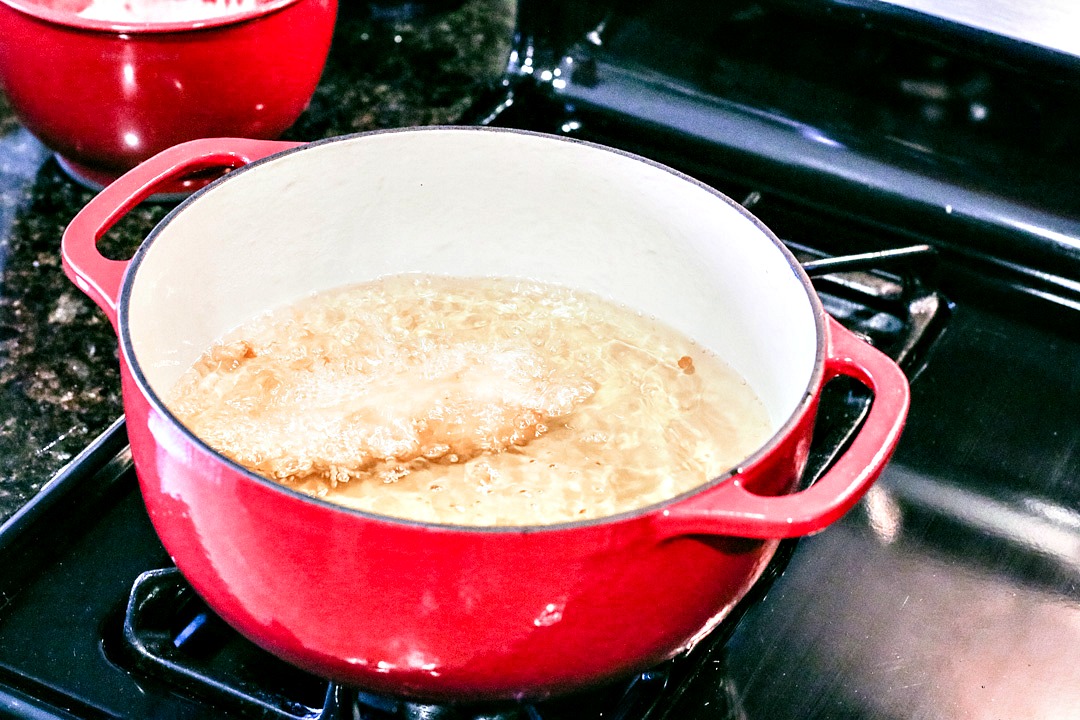Getting a taste of deep fried fish throughout our childhoods has turned many of us into seafood lovers—and if you’re not a seafood lover, chances are you at least dig a golden crisp fillet of beer-battered haddock or crunchy shrimp slathered in tangy seafood sauce. But—is it safe to deep fry fish at home on your stovetop?
Up until a few days ago, I’d never done it. Something about having a vat of blistering oil on my stovetop made me feel uneasy, but it was something I was going to have to get over eventually. After all, could I be a trusted pescetarian-focused blogger without a solid fish and chips recipe? (No.)
I’m happy to report that the process isn’t as terrifying as I imagined, but knowing what you’re doing and being safe is key.
Here’s how to deep fry fish on your stovetop.
Materials.
- An Enameled Cast Iron Dutch Oven
OR deep saucepan OR specialty wok
- Oil with a high smoke point (Peanut oil, vegetable oil, grapeseed oil, or canola oil, to name a few.)
- A deep-fat thermometer
OR candy thermometer
- A solid stainless steel strainer/skimmer
OR large slotted spoon
How to deep fry.
- When deep frying, you want to use a cooking oil that has a high smoke point of 400° F or higher. Fill your vessel no more than 2/3 of the way with oil. You really only want enough to submerge your food.
- Heat the oil slowly over moderate heat until the oil reaches 375° F (keep a close eye on it with the help of your thermometer).
- While your oil is coming to temperature, remove your fish from the fridge, throughly pat it dry, and season with salt and pepper. Bringing fish to room temperature results in an even cook, and patting it dry removes excess moisture. Water and oil don’t mix, and water and piping hot oil can create some kind of flaming hell.
- Once your oil reaches temperature, dredge your fillets in the batter and carefully place them into the fryer one by one. Don’t crowd the pot—cook one or two at a time.
- Cooking time will vary, depending on the thickness of your fillets. Plan to let them cook for about 2-4 minutes. The internal temperature of your fish should be 145° F when ready.
- Once the fish is cooked and the batter has turned into a golden crisp, carefully remove the fillets from the oil with your skimmer and place on a cooling rack or plate lined with paper towels to rid of excess oil.
Precautions and things to have handy.
- Clear the stovetop area of any flammable or loose items; have the lid to your vessel nearby, as well as some baking soda. It may seem extreme to have the baking soda out and ready, but you’re better safe than sorry.
- Never leave the oil unattended—not even for a moment.
- Do not overheat your oil. If the oil starts to smoke, the temperature is getting too high and you need to turn the stove off immediately in order to prevent a grease fire from igniting.
- Don’t overcrowd your deep fryer.
- Don’t splash water near hot oil and ensure any utensils you’re using are free of water beads.
If a grease fire occurs.
- Turn the stove off immediately.
- Place the vessel lid over the vessel to block oxygen and attempt to put the fire out. (You may want to do this with oven mitts on if they’re accessible to prevent burning your arms).
- Dump baking soda over any open flames to try and extinguish them. Do NOT throw water at a grease fire.
- You can also use damp (not wet) tea towels to try and put out flames.
- Don’t feel as though you’re being dramatic if you call 911. This isn’t a situation to wait out.
Do you have any helpful deep frying tips? Leave them in the comments below!
Here are some other useful ways to cook your fish:






